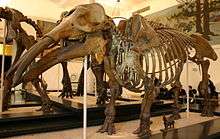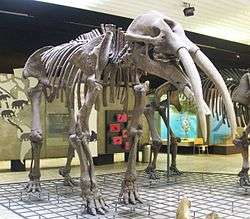Gomphotherium
| Gomphotherium Temporal range: Early Miocene–Early Pleistocene | |
|---|---|
 | |
| Specimen of Gomphotherium productum at the AMNH | |
| Scientific classification | |
| Kingdom: | Animalia |
| Phylum: | Chordata |
| Clade: | Synapsida |
| Class: | Mammalia |
| Order: | Proboscidea |
| Family: | †Gomphotheriidae |
| Genus: | †Gomphotherium Burmeister, 1837 |
| Species | |
|
Subgenus Gomphotherium
Subgenus Serridentinus
Subgenus Genomastodon
Incertae sedis
| |
| Synonyms | |
| |
Gomphotherium (/ˌɡɒmfəˈθɪəriəm/; "Welded Beast") is an extinct genus of proboscid that evolved in the Early Miocene of North America and lived for about 12.4 million years from 13.650—1.2 Ma.

The genus emigrated into Asia, Europe and Africa after a drop in sea level (probably during the Tortonian epoch) allowed them to cross over.[1] It survived into the Pleistocene, and its remains have been found in Sweden, France, Germany, Austria, Croatia,[2][3] Kansas, Tennessee, China,[4] Pakistan, Kenya and Bosnia and Herzegovina.[5]
Description


G. productum is known from a 35-year-old male 2.51 metres (8.2 ft) tall weighing 4.6 tonnes (4.5 long tons; 5.1 short tons). Even larger is G. steinheimense, known from a complete 37-year-old male found in Mühldorf, Germany, which is 3.17 metres (10.4 ft) tall and weighed 6.7 tonnes (6.6 long tons; 7.4 short tons).[6] It had four tusks, two on the upper jaw and two on the elongated lower jaw. The lower tusks are parallel and shaped like a shovel and were probably used for digging up food from mud. Unlike modern elephants, the upper tusks were covered by a layer of enamel. Compared to elephants, the skull was more elongated and low, indicating that the animal had a short trunk, rather like a tapir's. These animals probably lived in swamps or near lakes, using their tusks to dig or scrape up aquatic vegetation. In comparison to earlier proboscids, Gomphotherium had far fewer molars; the remaining ones had high ridges to expand their grinding surface. Gomphotherium inhabited dry wooded regions near lakes.
Taxonomy

The genus was erected by Burmeister (1837) and was assigned to Gomphotheriidae by Burmeister (1837), Qiu et al. (1981), Carroll (1988), Lambert and Shoshani (1998), Sach and Heizmann (2001), Sanders and Miller (2002) and Lambert (2007). Gomphotherium was considered paraphyletic by Lambert (2007). Serridentinus was named by Osborn (1923) and synonymized subjectively with Gomphotherium by Tobien (1972),[7] Madden and Storer (1985),[8] Shoshani and Tassy (1996),[9] Lambert (1996), Lambert and Shoshani (1998)[10] and Christiansen (2007).
The following cladogram shows the placement of the genus Gomphotherium among other proboscideans, based on hyoid characteristics:[11]
| |
| |||||||||||||||||||||||||||||||||
| |
References
- ↑ Alberdi, M. T.; Prado, J. L.; Ortiz-Jaureguizar, E.; Posadas, P.; Donato, M. (2007), "Historical Biogeography of Trilophoont Gomphotheres (Mammalia, Proboscidea) Reconstructed Applying Dispersion-Vicariance Analysis" (PDF), in Díaz-Martínez, E.; Rábano, I., Proceedings of the 4th European Meeting on the Palaeontology and Stratigraphy of Latin America, Zaragoza Spain 17–19 September 2007, Madrid: Instituto Geológico y Minero de España, pp. 9–14, ISBN 978-84-7840-707-1, retrieved 2008-07-28
- ↑ "Zaštićena područja - Moslavačka gora - Javna ustanova za upravljanje zaštićenim prirodnim vrijednostima Sisačko-moslavačke županije" (in Croatian). Retrieved 28 March 2011.
- ↑ "Miocene to Upper Pleistocene proboscids in Croatia" (in Croatian). Retrieved 8 February 2016.
- ↑ Wang, Wei; Liao, Wei; Li, Dawei; Tian, Feng (2014-07-01). "Early Pleistocene large-mammal fauna associated with Gigantopithecus at Mohui Cave, Bubing Basin, South China". Quaternary International. 354: 122–130. doi:10.1016/j.quaint.2014.06.036. ISSN 1040-6182.
- ↑ U Tomislavgradu otkriven kostur pretka slona, Večernji list, 2011-08-18. Retrieved 2011-08-26 (Croatian)
- ↑ Larramendi, A. (2016). "Shoulder height, body mass and shape of proboscideans" (PDF). Acta Palaeontologica Polonica. 61. doi:10.4202/app.00136.2014.
- ↑ H. Tobien. 1972. Status of the Genus Serridentinus Osborn 1923 (Proboscidea, Mammalia) and related forms. Mainzer Geowissenschaftliche Mitteilungen 1:143-191
- ↑ C. T. Madden and J. E. Storer. 1985. Canadian Journal of Earth Sciences 22
- ↑ J. Shoshani and P. Tassy. 1996. Summary, conclusions, and a glimpse into the future. in J. Shoshani and P. Tassy, eds., The Proboscidea: Evolution and Palaeoecology of Elephants and Their Relatives 335-348
- ↑ W. D. Lambert and J. Shoshani. 1998. Proboscidea. In C. M. Janis, K. M. Scott, and L. L. Jacobs (eds.), Evolution of Tertiary mammals of North America 606-621
- ↑ Shoshani, J.; Tassy, P. (2005). "Advances in proboscidean taxonomy & classification, anatomy & physiology, and ecology & behavior". Quaternary International. 126–128: 5. Bibcode:2005QuInt.126....5S. doi:10.1016/j.quaint.2004.04.011.
- http://www.elephant.se/gomphotherium.php
- http://www.aolnews.com/science/article/prehistoric-fossils-unearthed-in-jim-leydens-tenn-backyard/19541513?icid=main|main|dl1|link3|http%3A%2F%2Fwww.aolnews.com%2Fscience%2Farticle%2Fprehistoric-fossils-unearthed-in-jim-leydens-tenn-backyard%2F19541513
| Wikimedia Commons has media related to Gomphotherium. |